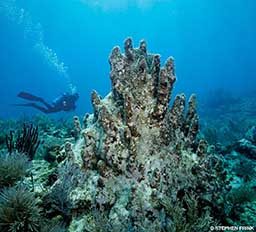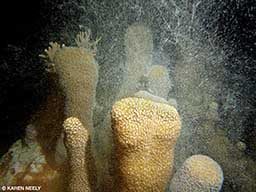There’s no mistaking pillar coral (Dendrogyra cylindrus) when you see it — it is unlike any other coral in the Greater Caribbean. With its tall columns and fluffy appearance, the pillar coral stands out like a rare unicorn for those who encounter it.
Throughout the Caribbean, a diver is most likely to encounter just a single colony, sometimes as tall as 12 feet and reaching nearly to the surface but rarely as a fluffy youngster resembling a piece of shag carpet. Occasionally, divers discover large stands of colonies, which are almost always clones of each other, the product of thousands of years of fragmentation and regrowth. As the only living species within its genus, the pillar coral is as unique in its taxonomy as it is in its growth form. It is also poorly studied — and it is in decline.

The International Union for Conservation of Nature and Natural Resources (IUCN) listed the species as vulnerable on its Red List in 2008, and in 2014 the National Oceanic and Atmospheric Administration (NOAA) listed it as threatened under the U.S. Endangered Species Act.
While many individuals and dive shops throughout the Caribbean monitor their local colonies, until recently there have been no coordinated assessments of pillar coral populations or health. Along the Florida Reef Tract, researchers initiated baseline studies in 2013 to determine the status of the population within the continental U.S. Expanding these studies to other regions is a research priority for upcoming years.
Using GPS coordinates supplied by survey programs and government agencies as well as dive shops and friends, divers made several hundred dives and concluded that pillar corals were alive at only about 150 sites along Florida’s 170-mile-long barrier reef. In the years that followed, those already low numbers took a dramatic turn for the worse. Battered by back-to-back bleaching events in 2014 and 2015 and victims of a dramatic disease outbreak that persists today, the population continues to plummet. By the summer of 2018 less than 40 percent of the original sites still had live pillar coral, and colonies at many of the remaining sites were actively diseased or were only a small fraction of their size a few years before.

According to Shel Silverstein’s poem The Unicorn, the reason you’ll never see a unicorn is because they missed the ark. Determined to not let that happen to the unicorns of the reef, NOAA coordinated a modern-day ark, forming a partnership with Mote Marine Laboratory, Keys Marine Laboratory and the Coral Restoration Foundation to take in fragments from the remaining pillar coral colonies, keep them isolated from waterborne diseases and protect them from warm summers. This protection allows them to slowly grow and build new tissue that may one day be returned to the wild reefs. The pillar coral ark currently holds almost 400 fragments representing 77 individuals, many of which are now extinct in the wild.
Pillar coral is presumed to be reproductively extinct on the Florida Reef Tract because no juveniles have been documented there. It is likely that one of the major bottlenecks is the space between colonies, which makes fertilization of eggs by distantly released sperm nearly impossible. The future of the species relies on building up as many genetically distinct individuals as possible to minimize inbreeding and increase the likelihood that some of the individuals will be more resistant to disease, bleaching or other stressors. Saving the existing individuals in the pillar coral ark is one way; helping to make more pillar corals is another.

Each year, under the warm breezes of the August full moon, boats of divers wait to splash into the dark waters. Their mission: to use syringes and plastic bags shaped into “coral condoms” to collect eggs and sperm from spawning pillars. Pillar corals are usually gonochoric, meaning there are male individuals and female individuals. The only noninvasive way to determine the gender is to watch during the three minutes each year that they spawn. With divers poised around colonies several miles apart, the teams swoop in to collect the spawn, then race back to the boats and speed toward each other, meeting in the middle of the ocean to mix together the gametes. Upon arrival at the dock, many samples already show early signs of cell division — the first step in the development of juvenile corals. Throughout the night and the following days, the babies develop into swimming larvae, pirouetting through the water column and finally settling on small concrete bases conditioned with pink crustose coralline algae.
Several months later, single polyp juveniles with symbiotic algae (zooxanthellae) residing in their tissues continue to grow. About the size of a pinhead, they can easily be overlooked by an inattentive eye, but their impact is enormous. They are likely the first new pillar coral individuals in Florida in decades or more. They represent the future of the species. On Florida’s reefs, these baby unicorns are the symbol of hope.

Research was conducted under Florida Keys National Marine Sanctuary permits FKNMS-2016-062-A2 and FKNMS-2016-156-A2.
| © Alert Diver — Q4 2018 |